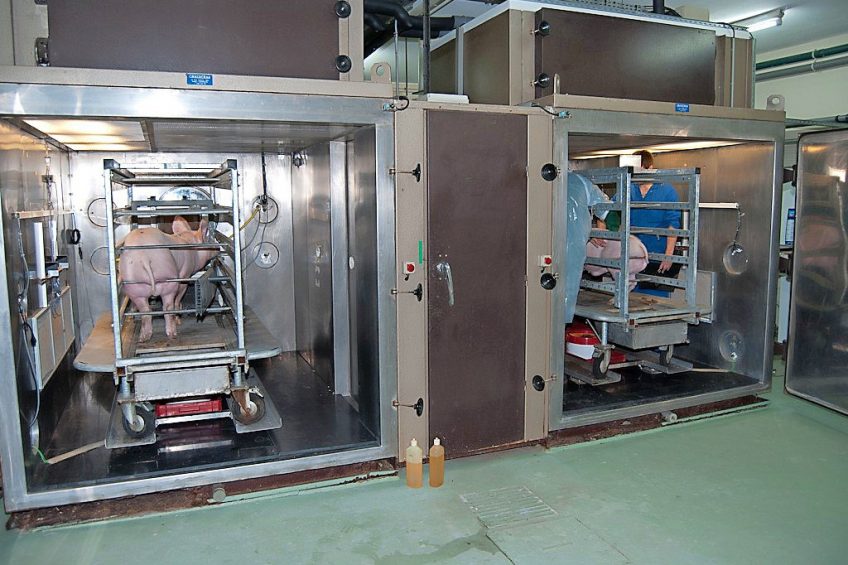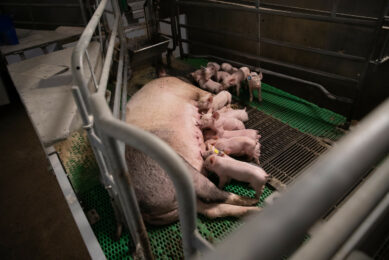How yeast can help sows to deal with high temperatures

Heat stress is not only a problem in tropical countries – also in moderate climates this can have an effect on productivity. Applying a yeast probiotic in diets has been shown, however, to be able to help sows with their digestion, even when temperatures rise.
Pigs are sensitive to heat. Sows above 25°C suffer from heat stress and their body and eating behaviour adapt to evacuate the heat generated by metabolic processes in their hot environment. It has been estimated in 2003 that heat stress generates economic losses to the swine industry of $ 299 million per year in the US alone.
Figure 1 – Survey of heat stress risks in farrowing rooms in Europe. Average daily percentage of time spent above 25°C (significant heat stress) and estimation of the associated feed intake reduction.

If the issues of heat stress and the mechanisms involved are well-known under tropical climates, it seems that the reality of the risk remains poorly estimated in other areas. A field survey was conducted by Lallemand Animal Nutrition during the summer of 2016 to evaluate the reality of heat stress on farms in Europe. Temperature and humidity were recorded every 30 minutes in the barn, at the level of the animals, thanks to electronic probes placed next to the trough. This survey gives a picture of the situation in farm conditions. Figure 1 summarises the data gathered from ten farms in Europe: the average amount of time spent daily above 25°C in the farrowing room is depicted.
In addition, based on the literature, the associated reduction of sow feed intake was calculated.
First, the results indicate that, even in countries considered as ‘temperate’, heat stress is a reality: Netherlands and Austria for example, are also at risk. This shows that heat stress is not only due to the climate, but housing conditions and ventilation management of the barns play an important part as well. This survey also confirms the cost of heat stress in terms of energy loss: between 0.6 to 2.5 kg per day of reduced feed intake in lactating sows have been calculated.
Figure 2 – Relationship between sow feed intake and ambient temperature.

A strain for health and performance
Above 25ºC the pig must adapt to maintain its body temperature: mechanisms that dissipate heat are increased while heat production is reduced. Digestion and metabolic utilisation of dietary nutrients is an important source of heat for the body: feed intake is strongly reduced during heat stress periods, with repercussions on growth or milk production in sows. The impact of feed intake is more important as the temperature rises (Figure 2). Other physiological functions are also affected, such as immunity or reproduction while energy is diverted towards thermoregulation.
For lactating sows, the combination of high ambient temperature and reduced feed intake has a huge impact on milk production. Back in 1993, researchers estimated that the reduction in milk yield under heat stress may be greater than would be expected from an equivalent decline in food intake for sows housed under thermoneutral conditions. This may result from a redirection of blood flow to the skin and away from other tissues, including the mammary gland to contribute to heat dissipation. The researchers showed that when ambient temperature increased from 18 to 28°C, milk production decreased by 25%.
The effects of heat stress on health are not negligible. It has been shown that serum endotoxin level is increased under heat stress. This can be linked to reduced immunity but also a weakened gut barrier function, which can lead to pathogens translocation from the gut lumen into the blood flow. Ileum and colon integrity is compromised in pigs under heat stress, due to reorganisation of the tight junction proteins.
True potential for microflora management
The use of probiotic yeast S. cerevisiae boulardii I-1079 (Levucell SB, Lallemand Animal Nutrition) to help control the digestive process and performance, under challenging conditions, is extensively documented. Users’ feedback indicated that its benefits could help ensure sows’ performance under heat stress situations, which is corroborated by field trials (see later).
The team of Etienne Labussière at the French National Institute for Agricultural Research (INRA Pegase), houses a modern experimental facility to study energy balance and metabolism in swine under controlled conditions (ambient temperature and relative humidity). These respiration chambers (pictured) were used to conduct an in-depth study about the effects of the live yeast supplementation on thermal heat acclimatisation and energy balance in swine.
In this experiment, finishing pigs were used as a model for swine and sows, since, the bigger the animal, the more sensitive it is to heat stress.
- 12 Pietrain × (Landrace × Large White) pigs received a cereal and soybean meal based diet supplemented or not with S. cerevisiae boulardii I-1079, supplementation starting two weeks before the test.
- For each diet, the pigs housed individually in the respiration chambers were subjected to one week at 22°C (thermoneutrality) followed by two weeks at 28°C (temperature increased gradually over two days to allow for animals’ adaptation).
- Different parameters were monitored, including individual live weight, eating behaviour, energy and nitrogen balances. Heat production was calculated through gas exchange measurements according to the principles of indirect calorimetry.
Results of this study indicate that the live yeast had a positive effect on growth performance under both thermo-neutral and heat stress ambient temperatures. However, the supplementation had a greater impact under heat stress as it was able to ‘compensate’ for the negative impact of heat on pig growth (see Figure 3).
Figure 3 – Evolution of pig live weight during the heat stress test for the control and live yeast diets.

This could be linked to two effects of the supplement:
- Improved feeding behaviour: the number of meals per day was significantly improved at thermoneutrality and during heat stress and the total daily feed intake was not affected by ambient temperature with the supplemented diet (Figure 4).
- Positive effect on energy metabolism: less energy is lost as heat production, hence made available for pig growth (higher energy retention).
This trial represents proof of concept of the effects of probiotic yeast on pig adaptation to heat stress. Nevertheless, metabolic regulations involved in pig adaptation to heat stress when fed probiotic yeast remains to be identified.
Figure 4 – Effect of S. cerevisiae boulardii I-1079* supplementation on pig dry matter intake during the heat stress test (blue: thermoneutral week, pink: heat stress conditions).

Live yeast benefits for lactating and gestating sows
Farm trials conducted with sows in the maternity pen confirm similar benefits in sows in field conditions: under heat stress conditions, sow feed intake is improved, which translates into improved piglet performance in lactation and at weaning (see Table 1).
For example, the trial conducted in Ceara State in Brazil under the supervision of Bruno Silva, from the University Federal de Minas Gerais, shows the effects of the live yeast supplementation of high-prolific sows both during gestation and lactation. This trial involved 300 Topigs sows of mixed parity. The sows were supplemented from day 90 in gestation up to weaning (24 days).
- During the last days of gestation, the supplementation leads to improved farrowing process (a benefit of S. cerevisiae boulardii I-1079 extensively documented under normal conditions). The number of live-born piglets was increased (13.37 vs.13.87 piglets/sow), while the mortality rate at birth decreased (5% vs. 4%).
- In lactation, sow feed intake was significantly higher under heat stress with the supplementation (also see Figure 5); leading to better preservation of the sow body reserves during this critical phase. Hence, the sows are better prepared for the next reproductive cycle.
- Consequently, piglets show better growth performance in lactation. Average daily gain is significantly improved by 8.2% vs. control. Consequently, at weaning, piglets are heavier (6.30 vs. 5.88 kg for control sows).
Figure 5 – Effect of S. cerevisiae boulardii I-1079* supplementation under heat stress on sow feed
intake in lactation.

Conclusion
Heat stress in pig production is an important and underestimated issue. Its effects are detrimental to performance and welfare, particularly through a reduction of feed intake and redirection of the animal metabolism. Beyond performance, health and reproductive performances can be affected at longer term.
The INRA study clearly demonstrated the benefits of managing the animal digestive system with specific live yeast under heat stress conditions, translating particularly to higher feed intake and improved feed efficiency, effects which have already been demonstrated in production situations in gestating and lactating sows. This supplement could represent a valuable tool to help alleviate the heavy toll of heat stress on pig production, in complement to relevant heat abatement strategies in the barn.
References available upon request.











